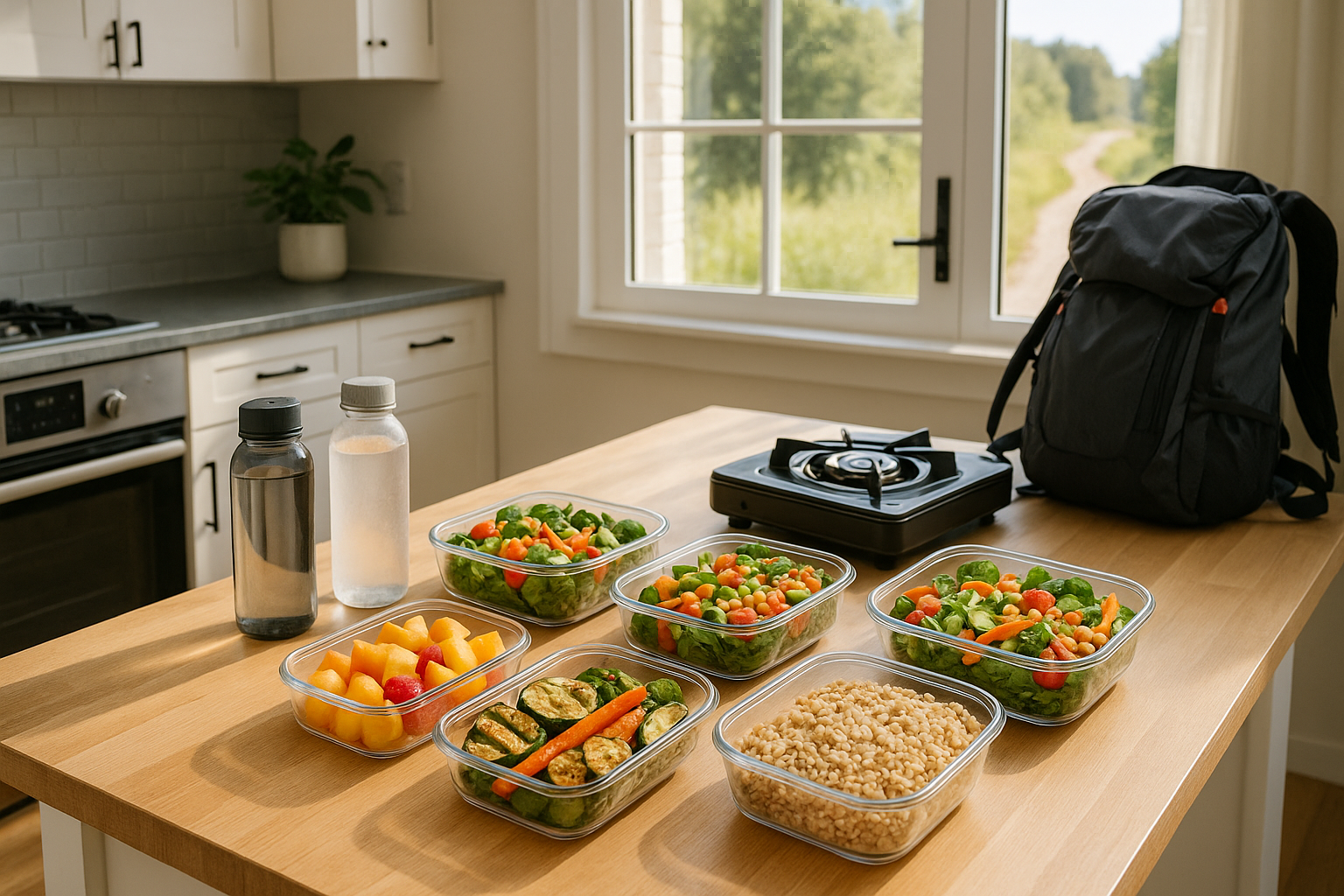For the intrepid voyager, meals on the go are a critical part of the journey – fueling their body and nourishing their spirit. Yet, the challenge of preparing nutritious, delicious, and easy-to-carry food can be a daunting task. How can one balance convenience and nutrition, without sacrificing taste and variety? Welcome to the exciting world of travel meal prep.
At first glance, travel meal prep might seem like a tedious chore. The thought of peeling, chopping, and cooking while juggling with bags, equipment, and maps can be overwhelming. But with the right strategies and some creative thinking, meal preparation can become a fun and enriching part of your travel experience. It is not merely a question of sustenance; it is about enjoying the journey as much as the destination. This article will guide you through the art of preparing and enjoying delicious, wholesome meals while you’re on the move.
We’ll delve into the practical aspects of travel meal prep, from choosing the right ingredients and kitchen equipment to understanding nutritional needs and dietary restrictions. We will explore innovative recipes that are travel-friendly, nutritious, and delicious. We’ll offer tips on how to pack meals efficiently and safely, ensuring that your food stays fresh and appetizing throughout your journey. We’ll also share insights on how to plan your meals strategically, considering factors like your travel itinerary, local food availability, and cultural food experiences.
Understanding the Basics: Nutrition On The Go
Before we dive into the specifics of meal preparation, it is essential to understand the unique nutritional needs of a traveler. Adventurous journeys often demand high physical activity – hiking, trekking, climbing, or simply carrying heavy luggage. This heightened level of physical activity necessitates a nutrient-dense diet to maintain energy and stamina. At the same time, the stress of travel can also impact digestion and immunity, underscoring the need for a balanced, immune-boosting diet. What does this mean for your travel meal prep? Let’s find out.
Exploring Travel-Friendly Ingredients
Not all foods are created equal, especially when it comes to travel. Some foods are easy to carry, require minimal cooking, and have a longer shelf life – making them ideal for your travel meal prep arsenal. On the other hand, some foods might be delicious but are not practical for travel due to their perishability or complex preparation process. We will explore a variety of travel-friendly ingredients, taking into account their nutritional value, shelf life, and ease of preparation.
Creating a Meal Prep Game Plan
Effective travel meal prep is not just about the ingredients; it’s about planning. A well-thought-out meal plan can make the difference between a stressful travel experience and a smooth, enjoyable journey. From planning meals around your travel itinerary to adjusting for local food availability, we will guide you in creating a meal prep game plan that fits your unique travel needs.
In this comprehensive guide to travel meal prep, you’ll find the tools, tips, and techniques to fuel your adventures with nutritious and delicious eats on the go. So whether you’re a seasoned traveler looking to elevate your meal game or a newbie just dipping your toes into the world of travel meal prep, this article is designed to help you navigate the journey with ease and confidence. So buckle up, it’s time to fuel your adventures!
Demystifying Travel Meal Prep: The Ultimate Guide
One of the significant challenges faced by adventure enthusiasts and frequent travelers is maintaining a healthy diet. This is often due to lack of access to nutritious food or limited time to prepare meals. However, with a bit of planning and knowledge, you can easily prepare delicious and nutritious meals for your travel adventures. In this article, we will discuss the different ways to simplify travel meal prep, ensuring you have delicious eats on the go.
Here, we will delve into the benefits of meal prep, different meal prep techniques, and how to store and pack your meals effectively. Moreover, we will provide some mouth-watering, yet easy-to-prepare travel meal recipes for your next adventure.
For a visual guide on travel meal prep, you can watch this informative video on YouTube titled “Travel Meal Prep Ideas for Healthy Eating on the Go” by Mind Over Munch. This video provides a step-by-step guide to meal prepping, which is especially useful for beginners.
The Art and Science of Travel Meal Prep
The process of meal prep involves planning, preparing, cooking, and packaging your meals in advance. This practice not only saves time but also ensures you have control over the ingredients used, thus allowing for healthier food choices. For adventurers and travelers, meal prepping can prove to be a lifesaver, particularly when access to nutritious food is limited.
Travel meal prep is both an art and a science. The science involves understanding the nutritional content of different ingredients, proper cooking techniques, and efficient packing methods. The art is all about creating visually appealing, delicious meals that would make you look forward to your next meal time.
To get started with travel meal prep, you’ll need some essential tools such as quality food containers, a portable cooler or insulated bag, and reusable cutlery. A good set of containers can make a huge difference in keeping your meals fresh and intact.
The Benefits of Travel Meal Prep
Travel meal prep offers several benefits, primarily when you are on the road or embarking on an adventure. Some of these benefits include:
- Time-Saving: With your meals ready in advance, you can save significant time during your travel.
- Cost-Effective: Prepping meals in advance can be cheaper than eating out, especially in tourist hotspots.
- Healthy Eating: You control the ingredients that go into your meals, enabling you to make healthier choices.
- Convenience: You have ready meals at your disposal, reducing the hassle of finding suitable dining options.
Planning Your Travel Meals: Factors to Consider
Planning is a crucial aspect of travel meal prep. A well-thought-out plan not only ensures you have nutritious meals during your journey but also helps avoid food waste. Here are some factors to consider when planning your travel meals:
1. Duration of Travel: The length of your journey will determine the number of meals and snacks you need to prepare. Consider the available food options during your travel and your destination. If you’re traveling to a remote location with limited dining options, you might need to prepare more meals in advance.
2. Dietary Restrictions: If you have dietary restrictions or preferences (e.g., vegan, gluten-free, dairy-free), plan your meals accordingly. Ensure you include a variety of ingredients to meet your nutritional needs.
3. Meal Variety: To avoid meal fatigue, include a variety of meals in your plan. Experiment with different recipes, flavors, and ingredients. You could also consider theme-based meals, such as Mexican, Italian, or Asian cuisine.
Creating Your Travel Meal Plan
Once you have considered the factors above, it’s time to create your meal plan. Here are some steps to guide you:
- Identify the number of meals and snacks you need.
- List down the recipes you want to prepare.
- Create a shopping list based on the ingredients required.
- Schedule a day for meal prepping.
Packing and Storing Your Travel Meals
Proper storage and packing are crucial to maintain the freshness and quality of your meals. Incorrect packing methods can lead to spoilage, leakage, or cross-contamination. Here are some tips to pack and store your travel meals effectively:
1. Use Quality Containers: Invest in quality food containers that are leak-proof and durable. Opt for containers with compartments to separate different food items. Bento boxes are a great option for this.
2. Keep Cold Foods Cold: Use a portable cooler or insulated bag to keep your meals cold, especially for long journeys. Include ice packs to maintain the temperature.
3. Organize Your Meals: Organize your meals in the order you plan to eat them. This way, you can easily access your meals without disturbing the other meals.
Now that you have a comprehensive guide on travel meal prep, it’s time to put these tips into action. Remember, practice makes perfect. The more you practice meal prepping, the better you’ll get at it. Happy meal prepping and safe travels!

Conclusion
In conclusion, we’ve travelled quite a journey together in this comprehensive discourse on the importance and application of various aspects of software engineering and Information Technology (IT). We have dissected and examined each element in detail, and I hope you now have a more in-depth understanding of these complex concepts.
Firstly, we started by discussing the fundamental building blocks of software engineering, explaining that it’s not just about writing code. It involves the structured process of understanding the user’s needs, designing the software, coding, testing, and finally, maintaining the software post-development. We reiterated the importance of each phase and how they build on each other to create a final product that is efficient and effective in meeting the user’s needs.
In the realm of IT, we delved into the significance of managing and maintaining systems, networks, and databases. We understood how they form the backbone of every organization and are crucial in this digital age. We further discussed the role of cybersecurity, and how it’s not just about protecting against external threats, but also about safeguarding our systems internally.
Following that, we dove into the intricate world of artificial intelligence (AI) and machine learning (ML). We saw how these revolutionary technologies have changed the landscape of how we interact with our devices and how they have the potential to drastically alter our future.
Lastly, we touched upon the value of good project management within the software engineering and IT sector. It’s not just about delivering on time and within budget, but also about managing risk, controlling quality, and communicating effectively with all stakeholders involved.
All these elements are integral parts of the larger puzzle that is software engineering and IT. The importance of understanding these concepts cannot be overstated, as they form the basis of our digital world. As we continue to become more reliant on technology, being aware of these aspects will become increasingly crucial.
I encourage you to dive deeper into these topics, explore further, and continue learning. This field is ever-changing and evolving, and it’s essential to stay updated and informed.
If you’ve enjoyed this article, feel free to leave a comment or share it with your peers. You never know, it might just spark an enlightening conversation or inspire someone to pursue a career in this dynamic and exciting field.
I have drawn from many resources in the creation of this article. Here are a few you may find useful in further expanding your knowledge:
1. IEEE Software Magazine
2. Information and Software Technology Journal
3. Journal of Network and Computer Applications
4. ACM Transactions on Intelligent Systems and Technology
Remember, the world of software engineering and IT is vast and ever-evolving. Don’t stop exploring, learning, and innovating. It’s a challenging journey, but one that’s richly rewarding. Keep striving, keep pushing, and above all, keep coding. Happy exploring!
[References: IEEE Software Magazine, Information and Software Technology Journal, Journal of Network and Computer Applications, ACM Transactions on Intelligent Systems and Technology]



